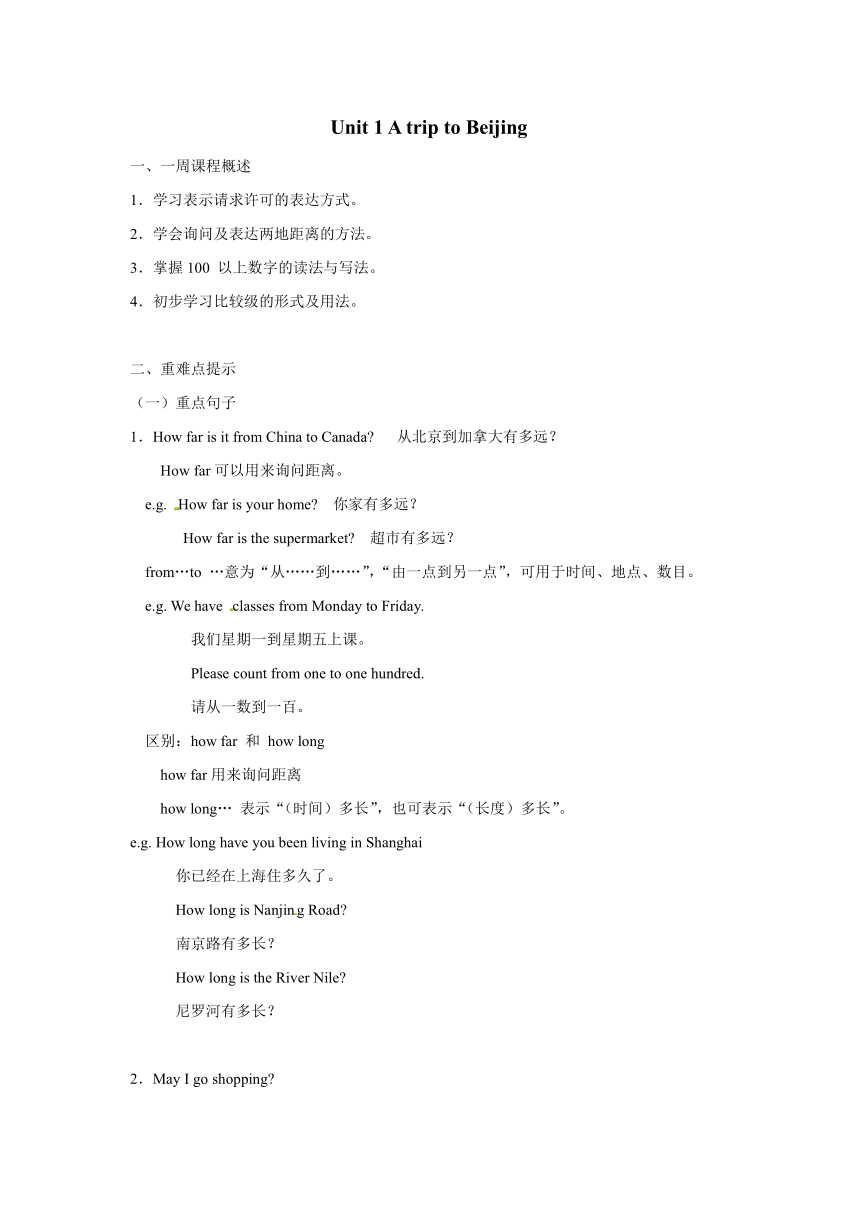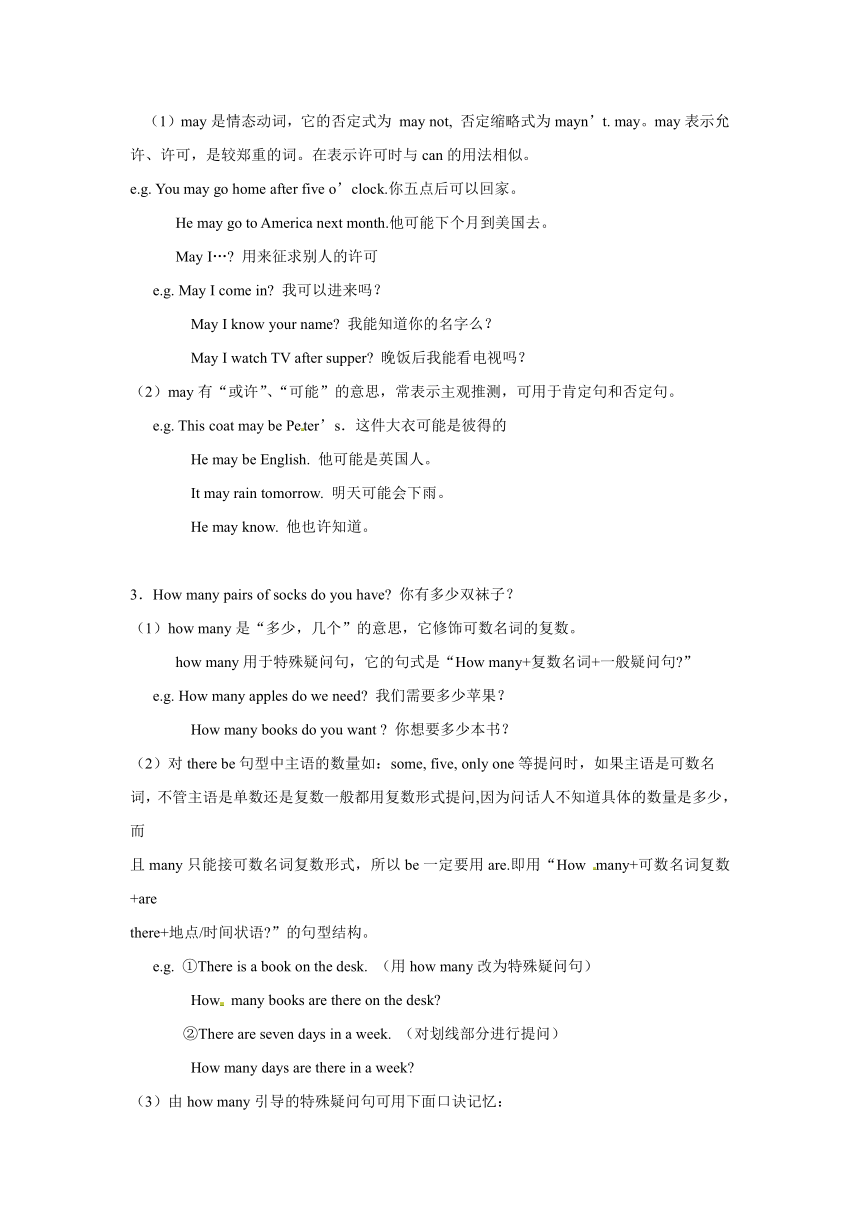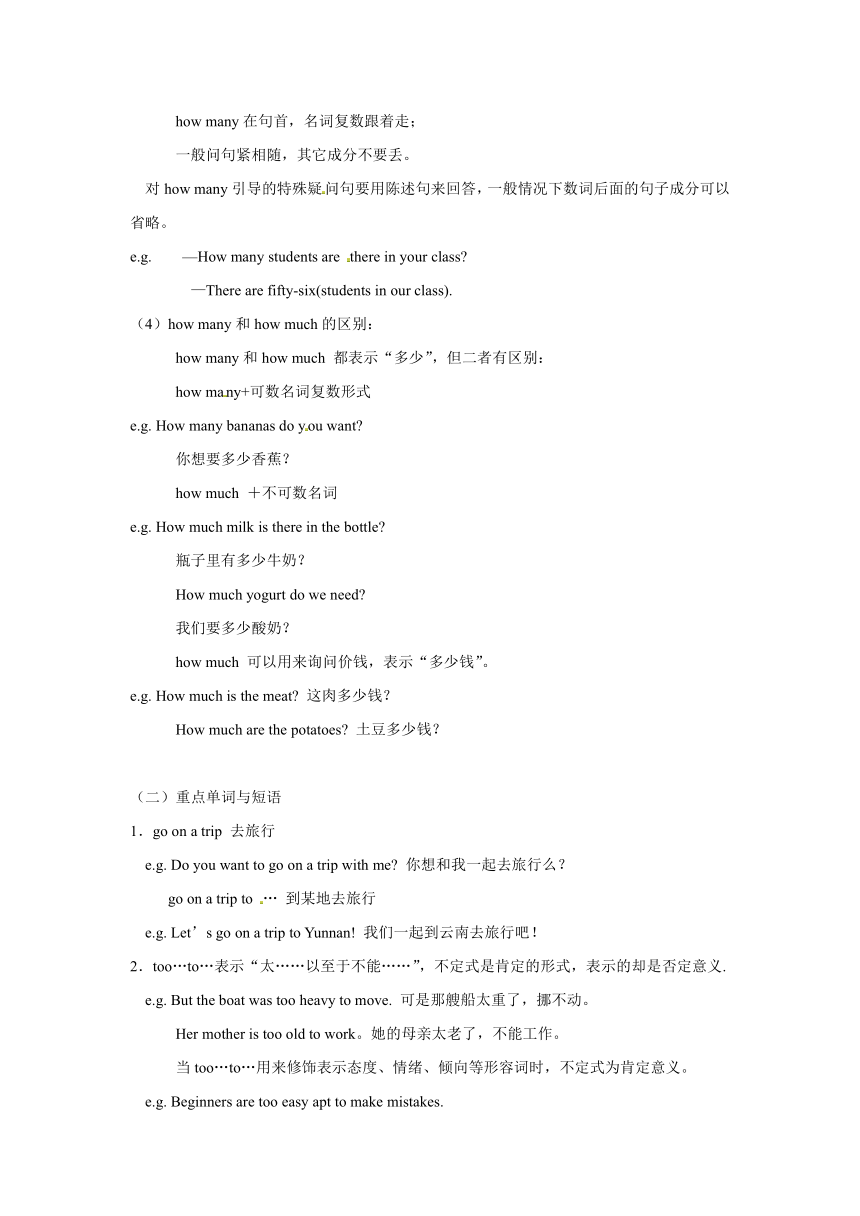冀教版英语七年级下册 Unit1 A trip to Beijing复习教案
文档属性
| 名称 | 冀教版英语七年级下册 Unit1 A trip to Beijing复习教案 |  | |
| 格式 | doc | ||
| 文件大小 | 89.0KB | ||
| 资源类型 | 教案 | ||
| 版本资源 | 冀教版 | ||
| 科目 | 英语 | ||
| 更新时间 | 2022-04-11 22:10:25 | ||
图片预览



文档简介
Unit 1 A trip to Beijing
一、一周课程概述
1.学习表示请求许可的表达方式。
2.学会询问及表达两地距离的方法。
3.掌握100 以上数字的读法与写法。
4.初步学习比较级的形式及用法。
二、重难点提示
(一)重点句子
1.How far is it from China to Canada 从北京到加拿大有多远?
How far可以用来询问距离。
e.g. How far is your home 你家有多远?
How far is the supermarket 超市有多远?
from…to …意为“从……到……”,“由一点到另一点”,可用于时间、地点、数目。
e.g. We have classes from Monday to Friday.
我们星期一到星期五上课。
Please count from one to one hundred.
请从一数到一百。
区别:how far 和 how long
how far用来询问距离
how long… 表示“(时间)多长”,也可表示“(长度)多长”。
e.g. How long have you been living in Shanghai
你已经在上海住多久了。
How long is Nanjing Road
南京路有多长?
How long is the River Nile
尼罗河有多长?
2.May I go shopping
(1)may是情态动词,它的否定式为 may not, 否定缩略式为mayn’t. may。may表示允许、许可,是较郑重的词。在表示许可时与can的用法相似。
e.g. You may go home after five o’clock.你五点后可以回家。
He may go to America next month.他可能下个月到美国去。
May I… 用来征求别人的许可
e.g. May I come in 我可以进来吗?
May I know your name 我能知道你的名字么?
May I watch TV after supper 晚饭后我能看电视吗?
(2)may有“或许”、“可能”的意思,常表示主观推测,可用于肯定句和否定句。
e.g. This coat may be Peter’s.这件大衣可能是彼得的
He may be English. 他可能是英国人。
It may rain tomorrow. 明天可能会下雨。
He may know. 他也许知道。
3.How many pairs of socks do you have 你有多少双袜子?
(1)how many是“多少,几个”的意思,它修饰可数名词的复数。
how many用于特殊疑问句,它的句式是“How many+复数名词+一般疑问句 ”
e.g. How many apples do we need 我们需要多少苹果?
How many books do you want 你想要多少本书?
(2)对there be句型中主语的数量如:some, five, only one等提问时,如果主语是可数名
词,不管主语是单数还是复数一般都用复数形式提问,因为问话人不知道具体的数量是多少,而
且many只能接可数名词复数形式,所以be一定要用are.即用“How many+可数名词复数+are
there+地点/时间状语 ”的句型结构。
e.g. ①There is a book on the desk. (用how many改为特殊疑问句)
How many books are there on the desk
②There are seven days in a week. (对划线部分进行提问)
How many days are there in a week
(3)由how many引导的特殊疑问句可用下面口诀记忆:
how many在句首,名词复数跟着走;
一般问句紧相随,其它成分不要丢。
对how many引导的特殊疑问句要用陈述句来回答,一般情况下数词后面的句子成分可以省略。
e.g. —How many students are there in your class
—There are fifty-six(students in our class).
(4)how many和how much的区别:
how many和how much 都表示“多少”,但二者有区别:
how many+可数名词复数形式
e.g. How many bananas do you want
你想要多少香蕉?
how much +不可数名词
e.g. How much milk is there in the bottle
瓶子里有多少牛奶?
How much yogurt do we need
我们要多少酸奶?
how much 可以用来询问价钱,表示“多少钱”。
e.g. How much is the meat 这肉多少钱?
How much are the potatoes 土豆多少钱?
(二)重点单词与短语
1.go on a trip 去旅行
e.g. Do you want to go on a trip with me 你想和我一起去旅行么?
go on a trip to … 到某地去旅行
e.g. Let’s go on a trip to Yunnan! 我们一起到云南去旅行吧!
2.too…to…表示“太……以至于不能……”,不定式是肯定的形式,表示的却是否定意义.
e.g. But the boat was too heavy to move. 可是那艘船太重了,挪不动。
Her mother is too old to work。她的母亲太老了,不能工作。
当too…to…用来修饰表示态度、情绪、倾向等形容词时,不定式为肯定意义。
e.g. Beginners are too easy apt to make mistakes.
初学者很容易犯错。
He was too eager to know the result of his examination.
他迫切想知道考试的结果。
The students are too pleased to speak English with the foreigners.
学生们很乐意同外国人讲英语。
They are too willing to help the poor.
他们非常乐意帮助穷人。
3.far from 离……多远
e.g. Is your home far from your school 你家离学校远吗?
He is far away from his hometown.他离他的家乡很远。
4.leave for 离开某地(到某地去);从……出发到……
e.g. We are leaving for Canada next week.
下星期我们要去加拿大。
When are you leaving for Shanghai
你打算什么时候离开上海?
5.arrive 是不及物动词,后面需接介词 at 或 in ,再和表示地点的名词连用。arrive at 通
常用于到达较小的地方,如车站、学校、邮局、机场等;arrive in 常用于到较大的地方,如城市、国家、地区等。
e.g. When did you arrive at the station
你是什么时间到达车站的?
When will you arrive at Huanggang
你们将会什么时候到达黄冈?
We arrived in Beijing this morning.
我们是今天早上到达北京的。
My brother arrives in Australia today.
我兄弟今天早上到达澳大利亚。
区别:arrive, reach与 get
(1)reach 是及物动词,后面直接跟地点名词。
e.g. They will reach Shanghai tomorrow afternoon.
他们将于明天下午到达上海。
(2)get 是不及物动词,后面需接介词 to,再和表示地点的名词连用。
e.g. They got to London last night. 他们昨天晚上到达伦敦。
(3)arrive, reach, get 后都可直接跟 here, there, home 等表示地点的副词。
e.g. When she reached (arrived, got) home, she had a short rest and a cup of tea.
当她到家时,她休息片刻,喝了一杯茶。
(三)语法小结
1.数字的读法:
数字单位:
百hundred,千thousand,百万million,十亿billion
(2) 读法:
百位数和十位数之间用and连接
202读作:two hundred and two
234读作:two hundred and thirty-four
每隔三位数就出现表示新单位,用逗号隔开。逆向第一个逗号读thousand;向左再推三
位,第二个逗号读million;第三个逗号读billion;第四个逗号就是trillion(兆)。
234读作: two hundred and thirty-four
2, 146读作:two thousand, one hundred and forty-six
1, 150读作:one thousand, one hundred and fifty
11, 234读作:eleven thousand two hundred and,thirty—four
155, 7读作:one hundred and fifty-five thousand, seven hundred and twenty-one
6, 155, 702读作:six million, one hundred and fifty-five thousand, seven
hundred and two
26, 000, 008读作:twenty-six million and eight
326, 414, 718读作:three hundred and twenty-six million, four hundred and
fourteen thousand, seven hundred and eighteen
在英语数字的读法上,只要记住基本的规则,即使增加相当的位数也不成问题。
2.比较级
比较级(Comparative Degree):指一个人或一件事物与另外的一个人或一件事物作大小、
新旧、性质、状态等程度的相比。
e.g.Tom is taller than Jack.
汤姆比杰克身材高。
This flower looks more beautiful than that one.
这朵花比那一朵更美丽。
(1)一般单音节(少数双音节)形容词的比较级和最高级的变化规则如下:
(2)双音节(以“辅音字母+y”结尾的除外)及多音节的形容词的比较级和最高级的变化方法是:在形容词原级前加more, most构成。如:
interesting-more interesting-most interesting
(3)不规则的形容词的比较级和最高级变化方法如下:
good(好的) / well(健康的)-better-best
bad(坏的) / ill(病的-worse-worst
many(很多的)/ much(很多的)-more-most
little(少)-less-least
一、一周课程概述
1.学习表示请求许可的表达方式。
2.学会询问及表达两地距离的方法。
3.掌握100 以上数字的读法与写法。
4.初步学习比较级的形式及用法。
二、重难点提示
(一)重点句子
1.How far is it from China to Canada 从北京到加拿大有多远?
How far可以用来询问距离。
e.g. How far is your home 你家有多远?
How far is the supermarket 超市有多远?
from…to …意为“从……到……”,“由一点到另一点”,可用于时间、地点、数目。
e.g. We have classes from Monday to Friday.
我们星期一到星期五上课。
Please count from one to one hundred.
请从一数到一百。
区别:how far 和 how long
how far用来询问距离
how long… 表示“(时间)多长”,也可表示“(长度)多长”。
e.g. How long have you been living in Shanghai
你已经在上海住多久了。
How long is Nanjing Road
南京路有多长?
How long is the River Nile
尼罗河有多长?
2.May I go shopping
(1)may是情态动词,它的否定式为 may not, 否定缩略式为mayn’t. may。may表示允许、许可,是较郑重的词。在表示许可时与can的用法相似。
e.g. You may go home after five o’clock.你五点后可以回家。
He may go to America next month.他可能下个月到美国去。
May I… 用来征求别人的许可
e.g. May I come in 我可以进来吗?
May I know your name 我能知道你的名字么?
May I watch TV after supper 晚饭后我能看电视吗?
(2)may有“或许”、“可能”的意思,常表示主观推测,可用于肯定句和否定句。
e.g. This coat may be Peter’s.这件大衣可能是彼得的
He may be English. 他可能是英国人。
It may rain tomorrow. 明天可能会下雨。
He may know. 他也许知道。
3.How many pairs of socks do you have 你有多少双袜子?
(1)how many是“多少,几个”的意思,它修饰可数名词的复数。
how many用于特殊疑问句,它的句式是“How many+复数名词+一般疑问句 ”
e.g. How many apples do we need 我们需要多少苹果?
How many books do you want 你想要多少本书?
(2)对there be句型中主语的数量如:some, five, only one等提问时,如果主语是可数名
词,不管主语是单数还是复数一般都用复数形式提问,因为问话人不知道具体的数量是多少,而
且many只能接可数名词复数形式,所以be一定要用are.即用“How many+可数名词复数+are
there+地点/时间状语 ”的句型结构。
e.g. ①There is a book on the desk. (用how many改为特殊疑问句)
How many books are there on the desk
②There are seven days in a week. (对划线部分进行提问)
How many days are there in a week
(3)由how many引导的特殊疑问句可用下面口诀记忆:
how many在句首,名词复数跟着走;
一般问句紧相随,其它成分不要丢。
对how many引导的特殊疑问句要用陈述句来回答,一般情况下数词后面的句子成分可以省略。
e.g. —How many students are there in your class
—There are fifty-six(students in our class).
(4)how many和how much的区别:
how many和how much 都表示“多少”,但二者有区别:
how many+可数名词复数形式
e.g. How many bananas do you want
你想要多少香蕉?
how much +不可数名词
e.g. How much milk is there in the bottle
瓶子里有多少牛奶?
How much yogurt do we need
我们要多少酸奶?
how much 可以用来询问价钱,表示“多少钱”。
e.g. How much is the meat 这肉多少钱?
How much are the potatoes 土豆多少钱?
(二)重点单词与短语
1.go on a trip 去旅行
e.g. Do you want to go on a trip with me 你想和我一起去旅行么?
go on a trip to … 到某地去旅行
e.g. Let’s go on a trip to Yunnan! 我们一起到云南去旅行吧!
2.too…to…表示“太……以至于不能……”,不定式是肯定的形式,表示的却是否定意义.
e.g. But the boat was too heavy to move. 可是那艘船太重了,挪不动。
Her mother is too old to work。她的母亲太老了,不能工作。
当too…to…用来修饰表示态度、情绪、倾向等形容词时,不定式为肯定意义。
e.g. Beginners are too easy apt to make mistakes.
初学者很容易犯错。
He was too eager to know the result of his examination.
他迫切想知道考试的结果。
The students are too pleased to speak English with the foreigners.
学生们很乐意同外国人讲英语。
They are too willing to help the poor.
他们非常乐意帮助穷人。
3.far from 离……多远
e.g. Is your home far from your school 你家离学校远吗?
He is far away from his hometown.他离他的家乡很远。
4.leave for 离开某地(到某地去);从……出发到……
e.g. We are leaving for Canada next week.
下星期我们要去加拿大。
When are you leaving for Shanghai
你打算什么时候离开上海?
5.arrive 是不及物动词,后面需接介词 at 或 in ,再和表示地点的名词连用。arrive at 通
常用于到达较小的地方,如车站、学校、邮局、机场等;arrive in 常用于到较大的地方,如城市、国家、地区等。
e.g. When did you arrive at the station
你是什么时间到达车站的?
When will you arrive at Huanggang
你们将会什么时候到达黄冈?
We arrived in Beijing this morning.
我们是今天早上到达北京的。
My brother arrives in Australia today.
我兄弟今天早上到达澳大利亚。
区别:arrive, reach与 get
(1)reach 是及物动词,后面直接跟地点名词。
e.g. They will reach Shanghai tomorrow afternoon.
他们将于明天下午到达上海。
(2)get 是不及物动词,后面需接介词 to,再和表示地点的名词连用。
e.g. They got to London last night. 他们昨天晚上到达伦敦。
(3)arrive, reach, get 后都可直接跟 here, there, home 等表示地点的副词。
e.g. When she reached (arrived, got) home, she had a short rest and a cup of tea.
当她到家时,她休息片刻,喝了一杯茶。
(三)语法小结
1.数字的读法:
数字单位:
百hundred,千thousand,百万million,十亿billion
(2) 读法:
百位数和十位数之间用and连接
202读作:two hundred and two
234读作:two hundred and thirty-four
每隔三位数就出现表示新单位,用逗号隔开。逆向第一个逗号读thousand;向左再推三
位,第二个逗号读million;第三个逗号读billion;第四个逗号就是trillion(兆)。
234读作: two hundred and thirty-four
2, 146读作:two thousand, one hundred and forty-six
1, 150读作:one thousand, one hundred and fifty
11, 234读作:eleven thousand two hundred and,thirty—four
155, 7读作:one hundred and fifty-five thousand, seven hundred and twenty-one
6, 155, 702读作:six million, one hundred and fifty-five thousand, seven
hundred and two
26, 000, 008读作:twenty-six million and eight
326, 414, 718读作:three hundred and twenty-six million, four hundred and
fourteen thousand, seven hundred and eighteen
在英语数字的读法上,只要记住基本的规则,即使增加相当的位数也不成问题。
2.比较级
比较级(Comparative Degree):指一个人或一件事物与另外的一个人或一件事物作大小、
新旧、性质、状态等程度的相比。
e.g.Tom is taller than Jack.
汤姆比杰克身材高。
This flower looks more beautiful than that one.
这朵花比那一朵更美丽。
(1)一般单音节(少数双音节)形容词的比较级和最高级的变化规则如下:
(2)双音节(以“辅音字母+y”结尾的除外)及多音节的形容词的比较级和最高级的变化方法是:在形容词原级前加more, most构成。如:
interesting-more interesting-most interesting
(3)不规则的形容词的比较级和最高级变化方法如下:
good(好的) / well(健康的)-better-best
bad(坏的) / ill(病的-worse-worst
many(很多的)/ much(很多的)-more-most
little(少)-less-least
同课章节目录
- Unit 1 A Trip to the Silk Road
- Lesson 1 A Trip to China
- Lesson 2 Meet You in Beijing
- Lesson 3 A Visit to Xi'an
- Lesson 4 A Visit to Lanzhou
- Lesson 5 Another Stop along the Silk Road
- Lesson 6 Jenny's Diary
- Unit 2 It's Show Time!
- Lesson 7 What's Your Project about?
- Lesson 8 Marco Polo and the Silk Road
- Lesson 9 Danny's School Project
- Lesson 10 Music and Dance
- Lesson 11 Food in China
- Lesson 12 A Blog about the Silk Road
- Unit 3 School Life
- Lesson 13 How Is School Going?
- Lesson 14 Jenny's School Life
- Lesson 15 Making a Difference
- Lesson 16 We Are with You!
- Lesson 17 School Science Fai
- Lesson 18 Teaching in China
- Unit 4 After-School Activities
- Lesson 19 A Dinner Date
- Lesson 20 Join Our Club!
- Lesson 21 What Is Your Club Type?
- Lesson 22 Big Plans for the Weekend
- Lesson 23 A Weekend with Grandma
- Lesson 24 How was Your Weekend?
- Unit 5 I Love Learning English!
- Lesson 25 A Phone Friend
- Lesson 26 Online Phone Calls
- Lesson 27 Amazing English
- Lesson 28 How Do I Learn English?
- Lesson 29 A Door to the World
- Lesson 30 Writing an E-mail in English
- Unit 6 Seasons
- Lesson 31 What Strange Weather!
- Lesson 32 I Can't Wait for Winter!
- Lesson 33 Kim's Favourite Season
- Lesson 34 Steven's Report
- Lesson 35 Surfing in Sydney
- Lesson 36 Spring in China
- Unit 7 Sports and Good Health
- Lesson 37 You Are What You Eat!
- Lesson 38 Stay Healthy!
- Lesson 39 Danny's Report
- Lesson 40 Move Your Body
- Lesson 41 Were People Healthy Then?
- Lesson 42 Know Yourself
- Unit 8 Summer Holiday Is Coming!
- Lesson 43 Have a Good Summer!
- Lesson 44 Volunteering in Summe
- Lesson 45 Baseball Season
- Lesson 46 Get Ready for Summer Holiday!
- Lesson 47 Summer Plans
- Lesson 48 Li Ming's Summer Holiday
